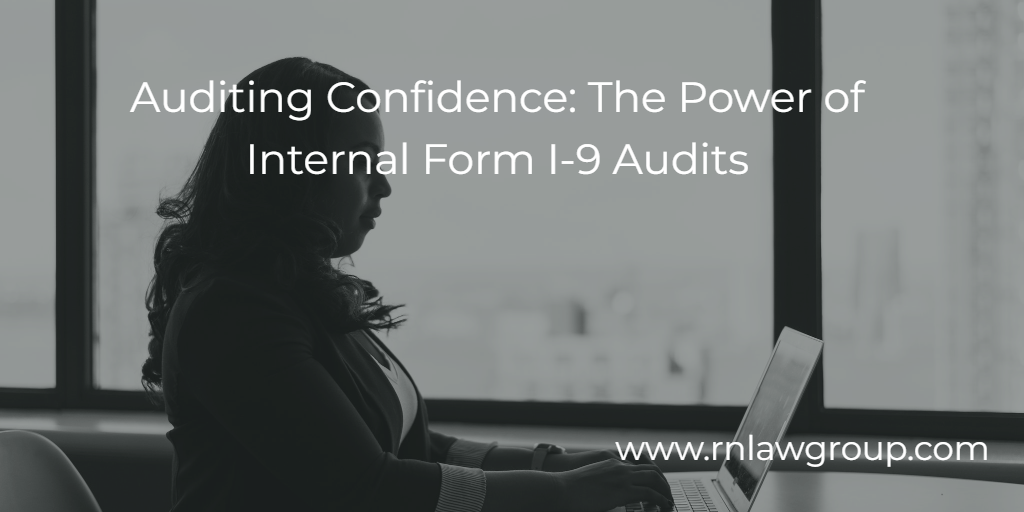
Auditing Confidence: The Power of Internal Form I-9 Audits
Form I-9, also known as the Employment Eligibility Verification Form, is an important document mandated by the U.S. government to ensure that individuals who are hired for employment in the United States have the legal right to work. Employers in the United States have an important duty to ensure that their employees are authorized to work in the country. The U.S. Citizenship and Immigration Services, also known as USCIS, created Form I-9 as an essential tool for U.S. employers to verify and ensure that their employees are legally authorized to work in the United States. This form serves as a critical step in the onboarding process and requires employers to carefully verify not only the identity of their employees but the employment eligibility of their workforce.
Regardless of citizenship status, all employees must have a completed Form I-9 on file. The timeline for the verification process is strict, and regulations dictate employers must complete Form I-9 within three days of the employee’s official hire date. This time restraint only emphasizes the urgency and importance of confirming the eligibility of every individual entering the workforce.
While on its face, Form I-9 appears to be a simple and straightforward document, compliance is key. There are many hurdles and intricacies which can cause serious issues for employers if they do not understand the rules and regulations. Failure to maintain compliance can result in severe fines and penalties as every mistake in completing the form can lead to the adding up of fines if an employer’s forms are audited by U.S. Immigration and Customs Enforcement, commonly known as ICE. An I-9 audit is designed to verify employees’ employment eligibility and to make sure that employers are complying with legal hiring processes.
As of January 13, 2023, for violations occurring after November 2, 2015, the penalties are as follows:
Substantive/Uncorrected Technical Paperwork Violations:
- Minimum fine per violation for substantive or uncorrected technical violations: $272.00
- Maximum fine per violation for substantive or uncorrected technical violations: $2,701.00
Knowingly Hiring or Continuing to Employ Unauthorized Workers:
- Penalty for first offense (per unauthorized worker): $676.00 to $5,404.00
- Penalty for second offense (per unauthorized worker): $5,404.00 to $13,508.00
- Penalty for third offense (per unauthorized worker): $8,106.00 to $27,018.00
(Source: Federal Register)
While not required by law, employers may conduct internal Form I-9 audits to ensure their continuing compliance with the regulations and requirements set forth by the Immigration Reform and Control Act (IRCA). Internal I-9 audits involve a comprehensive review of the company’s existing I-9 records to identify and rectify any errors, omissions, deficiencies, or potential compliance issues. Rather than waiting for ICE to come knocking on the door, conducting an internal I-9 audit allows the company to take a proactive approach.
One of the primary benefits of conducting an internal I-9 audit is the ability to identify errors and inconsistencies in the completion of Form I-9. By catching these mistakes early on, the company can rectify them and mitigate the risk of the penalties shown above.
Some of the more common mistakes include:
- Failure to complete the form in a timely manner: Employers must complete and sign Form I-9 within three (3) business days of the employee’s first date of work.
- Incorrect or incomplete information: Employers must ensure that all information provided by the employee is accurate and up-to-date.
- Accepting incorrect documentation: Employers must ensure that employees provide the correct and sufficient documentation to prove not only their identity but also their work authorization. The employer must also make sure that the documentation presented is unexpired and belongs to the employee in question.
- Failure to reverify work authorization: Employers must ensure that employees with temporary work authorization are reverified before the authorization expires.
- Failure to retain the form: Employers must keep Form I-9 on file for each employee for at least three years after the date of hire OR one year after the employee’s termination, whichever is later. The forms must be made available for inspection upon request of authorized government officials.
- Using an outdated form: USCIS periodically updates Form I-9 and employers must use the most current version.
As laws and regulations, including those related to Form I-9 completion and compliance, are often changing, conducting internal I-9 audits will help the company stay current with these changes, and ensure ongoing compliance and knowledge of the legal requirements. As previously mentioned, by conducting regular internal I-9 audits the company is proactively addressing potential compliance issues. In the event of a formal ICE audit of the company’s Form I-9s, this proactive approach could be taken into account to help mitigate possible penalties and legal consequences.
The company should have a policy in place that requires regular internal I-9 audits. Self audits may be performed by an employee of the company – though thorough training is necessary – or by outside immigration counsel. During an internal I-9 audit, the following should be completed:
- Verification that all employees currently on the company’s payroll have a Form I-9 on file;
- Verification that all terminated employees who are required to have a Form I-9 on file do;
- Verification that all Form I-9s on file have been completed properly;
- The creation of an audit note for each improperly completed Form I-9 to identify the error;
- Correction of any and all errors, inconsistencies, deficiencies, or omissions on the Form I-9s that are capable of being corrected; and
- A review of the current policies and procedures in place to reduce any future mistakes.
Alongside conducting regular internal I-9 audits, there are several best practices that employers should follow when completing Form I-9 to maintain compliance.
- Make sure to understand the requirements for Form I-9, including the deadlines for completion and the different types of documents deemed acceptable for verifying identity and work authorization.
- Train HR staff and hiring managers on how to properly complete Form I-9 including how to identify the acceptable documentation and how to avoid discrimination and non-compliance.
- Many employers now use an electronic I-9 system to simplify and streamline the process to ensure accuracy and completeness.
- A written I-9 policy should be developed to outline the procedures and determine who is responsible for completing the form. How errors and discrepancies will be addressed should also be determined.
In conclusion, Form I-9, the Employment Eligibility Verification Form, is a critical component of U.S. employment practices, ensuring that individuals hired have the legal right to work. The U.S. Citizenship and Immigration Services established this form as a cornerstone for employers to verify both identity and work eligibility during the onboarding process. Despite its seemingly straightforward nature, compliance with Form I-9 is essential, and failure to maintain it can result in severe penalties.
As the legal landscape evolves, maintaining a commitment to ongoing compliance through internal audits remains a strategic imperative for employers. By adhering to best practices and conducting regular internal I-9 audits, organizations not only fulfill their legal obligations but also create a foundation for a well-managed and legally compliant workforce.
Employers should prioritize ongoing compliance with Form I-9, recognizing the potential consequences of noncompliance. Conducting regular internal audits helps identify and rectify errors early on, reducing the risk of severe penalties. Staying informed about legal updates and implementing best practices ensures a well-managed and legally compliant workforce. Employers must remain diligent in the proper completion of the form and should seek legal advice when facing any uncertainty regarding Form I-9 requirements. For over 25 years, Reddy Neumann Brown PC has worked with employers to protect their businesses from the potential consequences of worksite noncompliance related to hiring and the retention of employees. Our firm guides employers to ensure full compliance with all Form I-9 requirements by conducting internal audits of a company’s records, processes, and procedures.
By: Jessica Palarca
Jessica Palarca is an attorney in Reddy Neumann Brown’s PERM Labor Certification Department where she assists clients in the beginning stages of the green card process.
Jessica earned her J.D. from the University of Houston Law Center in 2009 and was admitted into the Texas bar the same year. As the child of two immigrant parents, Jessica found her passion for immigration law early in her career. With over a decade of experience in both the private and non-profit sectors, she brings a different perspective to each case she handles. Through the years, Jessica has learned that to achieve the best possible results for each individual served, one must keep things simple and provide personalized attention and care to each case.

